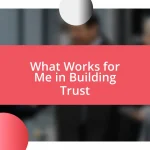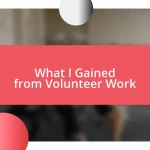Key takeaways:
- Community support during personal crises fosters deep connections and a sense of belonging, as demonstrated through meal trains and shared gardening experiences.
- Effective compassionate practices include active listening, empathy, inclusivity, supportive actions, and embracing vulnerability, which enhances community bonds.
- Building lasting impact involves consistent small actions, collective problem-solving during challenges, and celebrating individual strengths through collaborative events like talent shows.

Understanding Compassionate Communities
When I think about what makes a community compassionate, I can’t help but reflect on a time when my neighbor organized a food drive during a particularly tough winter. It was more than just gathering supplies; it brought us all together and highlighted how small acts can create profound connections. Isn’t it amazing how a single initiative can spark a sense of belonging among people who may barely know each other?
Compassionate communities thrive on empathy and understanding, weaving a tapestry of support that can uplift individuals in times of need. I once found myself struggling with a personal issue, and the community stepped in without hesitation. They didn’t just offer assistance; they listened and validated my feelings, creating a safe space for me to express my struggles. Isn’t this what we all seek—a sense of belonging where our emotions are understood?
Moreover, the essence of a compassionate community often lies in its ability to celebrate diversity while fostering inclusion. I’ve seen how different backgrounds and experiences enrich the community, leading to innovative solutions and deeper relationships. How do we cultivate an environment where everyone feels valued and heard? For me, it starts with open dialogues and genuine curiosity about one another’s stories.

My Journey into Compassionate Living
My journey into compassionate living began unexpectedly during a community gardening event. I was initially hesitant, thinking my lack of experience would hold me back. Yet, the warmth of my neighbors quickly changed that perception. They not only showed me how to plant but also shared personal stories related to their own gardens. It felt incredible to realize that we were connected by the ground beneath us and the seeds we were nurturing together.
One of the most powerful lessons in compassionate living came when a local family faced a medical crisis. In response, our community rallied around them, organizing meal trains and offering childcare. Witnessing this level of support was deeply moving. It was a tangible reminder that compassion isn’t just about feeling for someone; it’s about taking action. I remember cooking meals and delivering them, which made me realize how impactful these gestures can be—not only for those receiving help but also for those who offer it. The feeling of unity was overwhelming.
As I immersed myself further into this journey, I learned that compassion requires vulnerability, both in giving and receiving. I had to open up about my own experiences and, in return, I felt accepted and supported. Sharing my struggles not only lightened my own burden but also forged deeper bonds with those around me. Isn’t it interesting how vulnerability can lead to stronger connections? Through this ongoing journey, I’ve come to understand that compassionate living is truly a collective effort, one that we continuously nurture together.
| Aspect | My Experience |
|---|---|
| Initial Hesitations | I worried my lack of gardening experience would alienate me. |
| Community Support | I was moved by how we rallied together to support a family in crisis. |
| Bonds Through Vulnerability | Sharing my own struggles deepened my connections with others. |

Key Principles of Compassionate Practices
Compassionate practices are underpinned by several key principles that guide a community toward a more empathetic and inclusive environment. For me, one of the most important principles is active listening. When I took the time to truly listen to my neighbors during community meetings, I saw firsthand how it transformed conversations. People felt valued, and their stories mattered. That’s when I realized how often we overlook this simple act, yet it’s foundational in building trust and understanding.
Here are some key principles that I’ve found to be essential in fostering compassionate practices:
– Active Listening: Create a space where everyone feels heard and understood.
– Empathy: Put yourself in another’s shoes; it makes a world of difference.
– Inclusivity: Ensure everyone, regardless of background, has a voice.
– Supportive Actions: Move beyond words; take tangible steps to assist those in need.
– Vulnerability: Share your own experiences and emotions; it fosters deeper connections.
Engaging with these principles has opened my eyes to the power of collective action. I remember a time when our neighborhood banded together to support a local family in distress. The way various members voiced their willingness to help made me appreciate the importance of being reliable and approachable. Compassion isn’t solely about grand gestures—sometimes, even the smallest acts can create ripples of support that uplift the entire community.

Engaging with Community Members
One memorable experience of engaging with community members happened during a neighborhood clean-up event. As I picked up litter alongside my neighbors, we shared laughter and stories. It was surprising how a simple task created an atmosphere of camaraderie, reminding me that connection can often blossom from shared purpose. Have you ever felt that sense of unity over a common goal?
I noticed that engaging with members involved more than just showing up; it required genuine curiosity. One evening, I attended a potluck dinner where everyone brought a dish that represented their culture. It felt transformative to hear their stories while we savored different flavors. Listening to their life experiences deepened my understanding and appreciation of diverse perspectives. I left that night with a heart full of warmth; isn’t it fascinating how food can break down barriers and foster relationships?
Over time, I began to understand that creating bonds takes consistent effort. I started hosting monthly coffee chats to encourage a relaxed setting where everyone could share thoughts and experiences. These gatherings gradually became a safe space, allowing members to express their joys and challenges. When I see how much everyone looks forward to these meetings, it reinforces my belief that nurturing ongoing dialogues truly enriches our community fabric. Do you think small gatherings can have such a profound impact? I certainly do.

Facing Challenges in Community
Sometimes, it feels like challenges in a community can weigh heavy on everyone involved. I recall a particularly tough winter when several families faced financial hardships due to job losses. During that time, we organized a community meeting to address the struggle, and I remember how nervous I felt stepping into that space, unsure of what to say. But as we shared our stories, a remarkable sense of solidarity emerged. It dawned on me just how powerful vulnerability could be in fostering connection. Have you ever felt that sense of togetherness in tough times? It’s one of those experiences that sticks with you.
Navigating community challenges often requires creativity and action. I found that when we focused not just on the problems but on practical solutions, the community thrived. For instance, after our meeting, we brainstormed ways to support those in need. We initiated a “give what you can, take what you need” pantry. Watching people come together to contribute food was nothing short of inspiring. It reinforced my belief that collective problem-solving has the power to revitalize communities. Don’t you find it fascinating how a simple idea can transform the narrative during challenging times?
Yet, fostering compassion in the face of adversity doesn’t come without its hurdles. I often feel the weight of skepticism from some community members who worry that efforts may not yield significant change. I remember discussing this with a close friend over coffee; she was hesitant to jump into initiatives because she felt they wouldn’t make a difference. That conversation made me realize the importance of nurturing hope and perseverance. By sharing uplifting stories—like how our pantry helped families weather the winter—people began to see the seeds of change growing right before their eyes. What can we do to inspire those around us to believe in the power of community support? I think we simply need to keep showing up and sharing our progress.

Building a Lasting Impact Together
Building a community that leaves a lasting impact requires a shared vision and committed hearts. I recall meeting with a small group of friends to brainstorm ways we could support our local youth. Over a simple cup of coffee, we unleashed our creative juices, and by the end of the evening, we had founded a mentorship program. That moment showed me how collaboration can spark profound change—what can your unique group create when united in purpose?
I’ve learned that the benefits of community-building extend far beyond individual initiatives. One warm summer afternoon, we organized a talent show to uplift local talents and engage all ages. I still remember the joy on children’s faces as they took the stage, filled with excitement and nerves. The applause echoed not just for the performers but for the sheer effort of coming together as a community. Doesn’t it remind you how powerful it is when everyone rallies to celebrate one another’s gifts? It’s a reminder that acknowledging everyone’s strengths creates an environment ripe for growth.
The essence of building a lasting impact is in the little daily actions we take. I’ve seen firsthand how simple gestures, like regularly checking in on neighbors or offering to help with errands, can weave a tighter community fabric. Once, I dropped off homemade cookies to a family going through a rough patch, and their grateful smiles linger in my memory. It reinforced my belief that kindness doesn’t need a grand stage; it thrives in the small, meaningful connections we foster every day. Have you ever experienced a moment that lingered long after it happened? Sometimes, a simple act can ripple through the community in ways we can’t even foresee.















